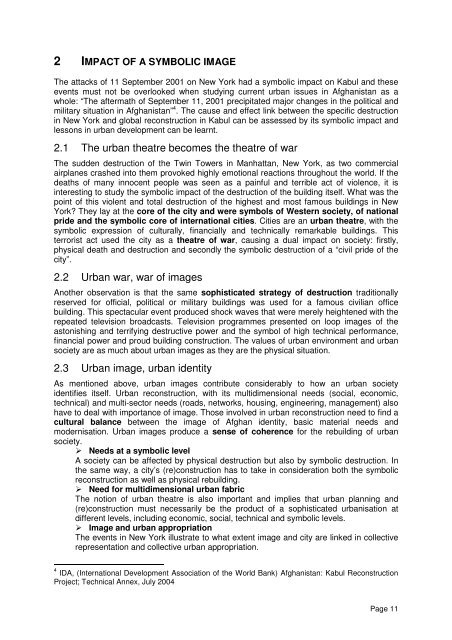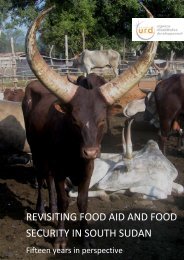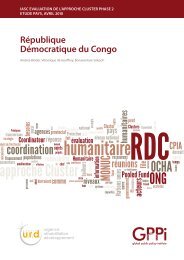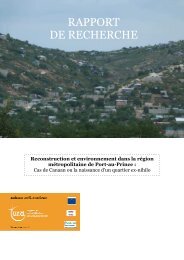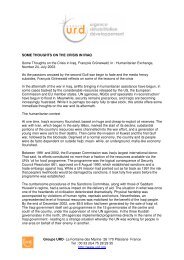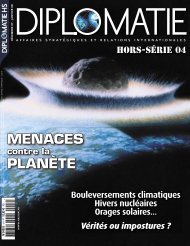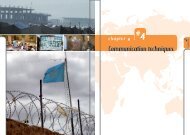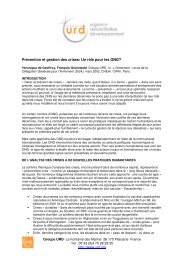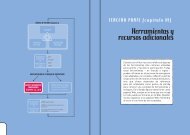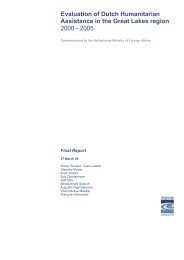Kabul Urban Survey - Groupe URD
Kabul Urban Survey - Groupe URD
Kabul Urban Survey - Groupe URD
Create successful ePaper yourself
Turn your PDF publications into a flip-book with our unique Google optimized e-Paper software.
2 IMPACT OF A SYMBOLIC IMAGE<br />
The attacks of 11 September 2001 on New York had a symbolic impact on <strong>Kabul</strong> and these<br />
events must not be overlooked when studying current urban issues in Afghanistan as a<br />
whole: “The aftermath of September 11, 2001 precipitated major changes in the political and<br />
military situation in Afghanistan” 4 . The cause and effect link between the specific destruction<br />
in New York and global reconstruction in <strong>Kabul</strong> can be assessed by its symbolic impact and<br />
lessons in urban development can be learnt.<br />
2.1 The urban theatre becomes the theatre of war<br />
The sudden destruction of the Twin Towers in Manhattan, New York, as two commercial<br />
airplanes crashed into them provoked highly emotional reactions throughout the world. If the<br />
deaths of many innocent people was seen as a painful and terrible act of violence, it is<br />
interesting to study the symbolic impact of the destruction of the building itself. What was the<br />
point of this violent and total destruction of the highest and most famous buildings in New<br />
York? They lay at the core of the city and were symbols of Western society, of national<br />
pride and the symbolic core of international cities. Cities are an urban theatre, with the<br />
symbolic expression of culturally, financially and technically remarkable buildings. This<br />
terrorist act used the city as a theatre of war, causing a dual impact on society: firstly,<br />
physical death and destruction and secondly the symbolic destruction of a “civil pride of the<br />
city”.<br />
2.2 <strong>Urban</strong> war, war of images<br />
Another observation is that the same sophisticated strategy of destruction traditionally<br />
reserved for official, political or military buildings was used for a famous civilian office<br />
building. This spectacular event produced shock waves that were merely heightened with the<br />
repeated television broadcasts. Television programmes presented on loop images of the<br />
astonishing and terrifying destructive power and the symbol of high technical performance,<br />
financial power and proud building construction. The values of urban environment and urban<br />
society are as much about urban images as they are the physical situation.<br />
2.3 <strong>Urban</strong> image, urban identity<br />
As mentioned above, urban images contribute considerably to how an urban society<br />
identifies itself. <strong>Urban</strong> reconstruction, with its multidimensional needs (social, economic,<br />
technical) and multi-sector needs (roads, networks, housing, engineering, management) also<br />
have to deal with importance of image. Those involved in urban reconstruction need to find a<br />
cultural balance between the image of Afghan identity, basic material needs and<br />
modernisation. <strong>Urban</strong> images produce a sense of coherence for the rebuilding of urban<br />
society.<br />
Needs at a symbolic level<br />
A society can be affected by physical destruction but also by symbolic destruction. In<br />
the same way, a city’s (re)construction has to take in consideration both the symbolic<br />
reconstruction as well as physical rebuilding.<br />
Need for multidimensional urban fabric<br />
The notion of urban theatre is also important and implies that urban planning and<br />
(re)construction must necessarily be the product of a sophisticated urbanisation at<br />
different levels, including economic, social, technical and symbolic levels.<br />
Image and urban appropriation<br />
The events in New York illustrate to what extent image and city are linked in collective<br />
representation and collective urban appropriation.<br />
4 IDA, (International Development Association of the World Bank) Afghanistan: <strong>Kabul</strong> Reconstruction<br />
Project; Technical Annex, July 2004<br />
Page 11


